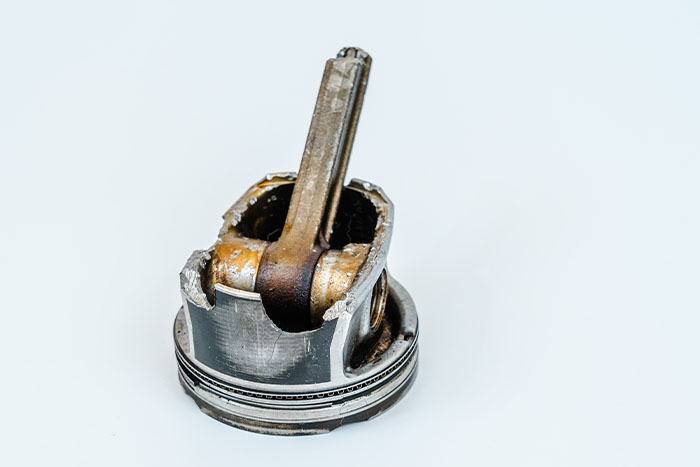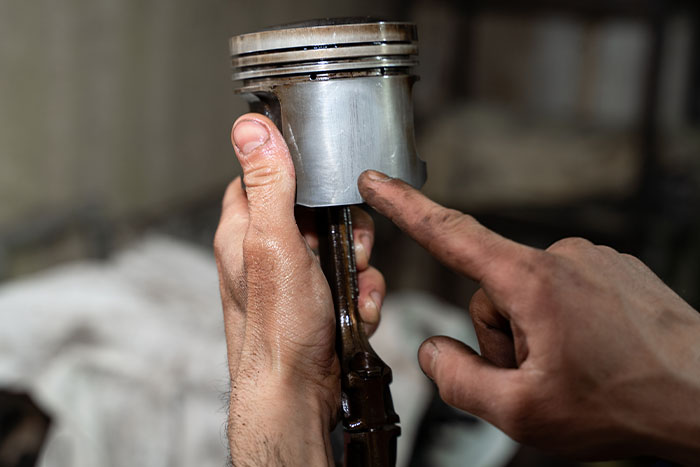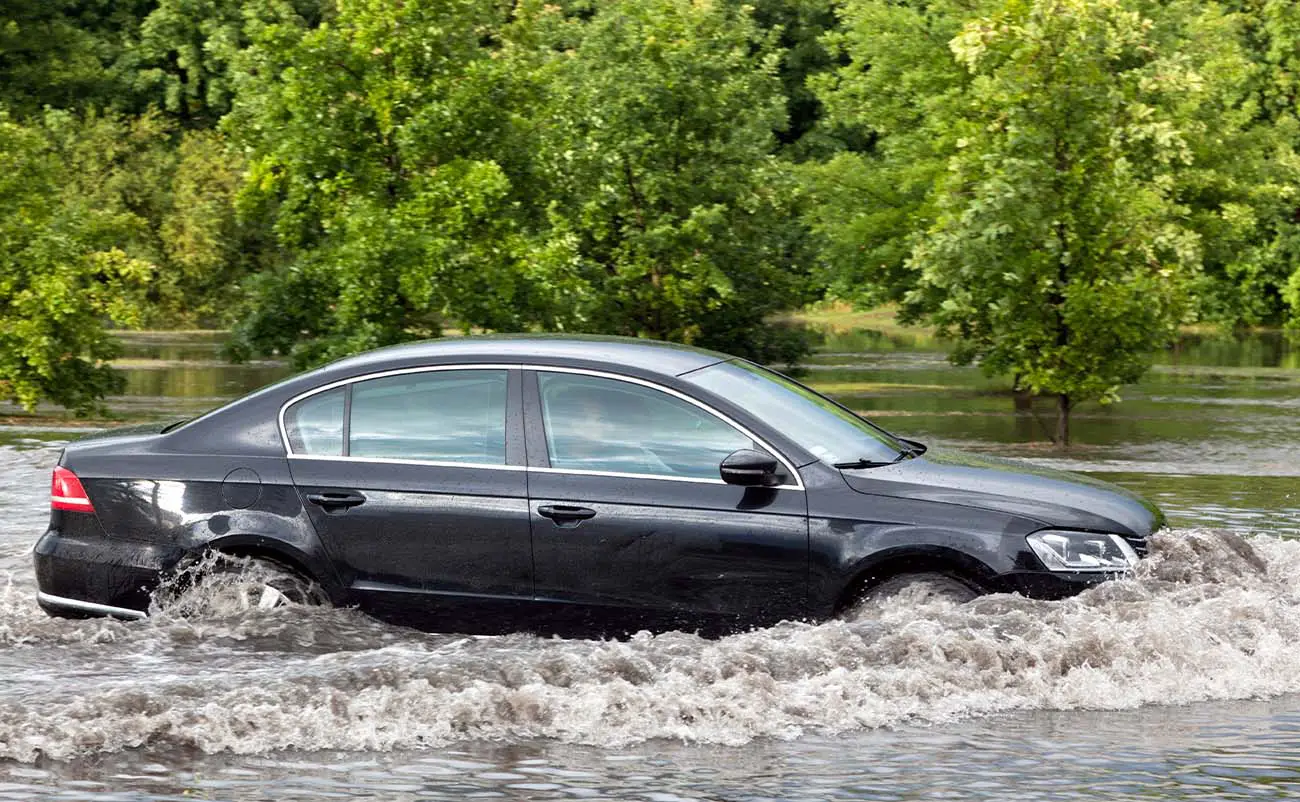If you own a car long enough, you will eventually be faced with some car repairs. Many vehicle repairs are minor and not extremely complicated to perform. However, a hydrolocked engine is one of the worst situations you might find yourself in as a car owner. Thankfully, hydrolocking is not common, and most people will never encounter this situation.
So, what is hydrolocking, and how does it happen? It could result from driving through water that is too deep or simply allowing the vehicle to sit too long without cranking. Keep reading, as we’ll give you all the details about what a hydrolocked engine is, what causes it, and how you can fix it. Let’s get started!
Table of Contents
What Is A Hydrolocked Engine?
A hydrolocked engine is an engine that is seized due to the presence of water or other fluid inside the cylinder walls. Using the prefix “hydro,” you can see that the word literally means “water locked.” Remember how an internal combustion engine works? The connecting rods are attached to the crankshaft, and as the crankshaft spins, the rods push the pistons up and down inside the cylinder walls. As the pistons move, they compress the air/fuel mixture inside the combustion chamber of the cylinder head. Air is easy to compress and does not require much force to reach the necessary pressure.
However, water is not easily compressed. If water enters the cylinder, the piston is unable to compress the water. Therefore, the engine will seize as the piston attempts to move up in the engine cylinder. If the engine is running when this happens, it could lead to bent connecting rods, broken pistons, a blown head gasket, or even a crack in the engine block. When an engine hydrolocks as it’s running, it will almost always lead to further damage. At that point, you will be looking at a lot more money than just the cost to repair a blown head gasket.
A hydrolocked engine can also be the result of an engine that has sat for a long time. In that case, the engine likely will not turn over as you attempt to start it. Thankfully, the hydrolocking probably has not led to further engine damage in this case. So, what will cause hydrolocking to happen? We’ll give you the details in the next section.
What Causes An Engine To Hydrolock?
The most common cause of a hydrolocked engine is water entering the intake and getting inside the cylinders. This can happen if you drive through standing water that is too deep for your vehicle. Your engine’s air filter and air intake sit inside the engine bay. Only air should enter the intake; however, driving through a deep puddle can cause water to get pulled inside the intake. This is similar to swallowing water and having it go down your airway instead. Although you can generally cough the water back out, your car’s engine cannot do this. Instead, it could become hydrolocked.
Some people choose to install a cold air intake on their engine to increase their engine performance. However, this can be dangerous and make your engine more susceptible to hydrolocking. Most cold air intakes sit low in the engine bay to pull in cooler air from outside the engine compartment. However, this can also cause them to pull in water as well. You should be keenly aware of the water level of puddles before driving through them, as even a small amount of water in your intake can cause problems.
Similarly, too much coolant inside your cylinder can cause a hydrolocked engine. If you have a blown head gasket or other issue causing engine coolant to enter the combustion chamber, you could soon experience a hydrolocked engine. Typically, very small amounts of water or coolant in the combustion chamber might burn and cause your vehicle to act like a steam engine. However, too much water or coolant will result in hydrolock. Hydrolock can even result from too much fuel in the cylinder caused by a leaking fuel injector.
Engine Damage Caused By Hydrolocking

So, how much damage can hydrostatic lock cause to an engine? The answer is a lot, especially if the engine is running when it happens! If your engine is only idling, you might get lucky and have the engine stall when the hydrolock occurs. In that case, you might not experience much additional damage. However, if you are driving or accelerating when water gets inside the cylinders, you will likely see a lot of additional damage.
Some typical damage resulting from hydrolock includes bent connecting rods, damaged pistons, fouled spark plugs, bent valves, or a blown head gasket. In extreme cases, you might even see severe damage to the crankcase, such as a hole or crack in the engine block. Your engine speed at the time of the hydrolocking will generally have a direct result on the extent of the damage.
If you experience a locked engine due to non-use, you likely won’t have extensive damage. However, you can expect corrosion to internal components, like the piston rings, cylinder walls, and pistons. You will likely still need an automotive repair shop to perform some work on the engine to get things working properly again.
Symptoms Of A Hydrolocked Motor
Are you wondering how you can tell if you have a hydrolocked motor? Don’t worry; it will be pretty obvious! More than likely, the engine failure will occur almost immediately after driving through water that is too deep. Many people wonder, “What does a hydrolocked engine sound like?” You might hear or feel your engine sputtering briefly, but then it is likely to come to an abrupt stop. After that, no sound will be made because the engine will not crank again. This is a clear signal that water has entered your intake system, and your engine has become hydrolocked.
If the hydrolocking occurs as a result of too much oil or coolant in the cylinder, you might see some warning signs beforehand. When coolant gets burned in the engine, you will notice white smoke coming from the tailpipe. Similarly, burning oil usually results in blue smoke from the tailpipe. Most of the time, these failures do not happen instantly. If you notice smoke coming from your exhaust, you should get your car to a mechanic right away. Catching the problem early will likely result in less severe damage and a lower repair cost.
Hydrolocked Engine Repair

The effort required to repair a hydrolocked engine depends on the severity of the damage. If your motor is idling when the hydrolocking occurs, it might simply stall and not cause further damage. In that case, a mechanic might be able to repair it without a complete engine teardown. If the repair happens soon enough, the mechanic may be able to remove the spark plugs and allow the water to push out of the cylinders. An immediate oil change will also be necessary, and one or more spark plugs might need replacing. If no corrosion has occurred to the internal components of the engine, this should get the engine back up and running.
On the other hand, if internal damage to the engine has occurred, it will require an engine rebuild in most cases. It is likely that you will need to replace connecting rods, piston rings, and maybe even pistons. In the most severe cases, a complete engine replacement will be needed. Now you see why it is so important to keep your car out of deep puddles!
Cost To Repair An Engine That Is Hydrolocked
You might be wondering how much a hydrolocked engine is going to cost you to repair. The bad news is that the repair bill is going to be pretty high in most cases. If you are one of the lucky ones and only need to push out the water and perform an oil change, then your bill is likely to be less than $500. However, repair bills for a hydrolocked engine go up significantly from there.
The cost of an engine rebuild can be anywhere from $2,500 to $4,000 for most engines, and total engine replacement ranges from $4,000 to $8,000. In some cases, the cost of the repair outweighs the value of the vehicle. If you find yourself in that situation, you might decide to sell your car for scrap and buy a new one. Selling your car for scrap could net you a few hundred dollars to use as a down payment on a new vehicle.
The Bottom Line
Hydrolocked engines are not common, but get ready for a big repair bill if you encounter one. Hydrolocking occurs when water or other fluids enter the cylinders of your engine and prevent the pistons from moving. This most frequently happens when you drive through deep water, and the intake pulls water into the engine instead of air. The worst damage will occur if the engine is running at high speed, and you might see bent rods, bent valves, broken pistons, or even a cracked engine block in that case. If your starter motor cannot turn your engine over when you attempt to crank it, get the vehicle to a repair shop immediately. The longer you wait, the more internal corrosion will occur.
Frequently Asked Questions
Can a hydrolocked engine be fixed?
Most hydrolocked engines can be repaired, although the repair cost might be extremely high in some cases. At a minimum, the water will need to be removed from the cylinders. You will also need to change the oil and likely replace some spark plugs. In more severe cases, the engine will need to be rebuilt — replacing damaged connecting rods, damaged pistons, piston rings, and even bent valves. There are some situations where the damage is so extensive that it cannot be repaired. You will need a total engine replacement in that case.
What is the most common cause of hydrolocked engines?
The most common cause of hydrolocked engines is water entering the air intake. This can happen when you drive through a deep puddle, especially if you have a cold air intake installed on your vehicle. In addition, a blown head gasket can allow coolant to enter the cylinders and cause hydrolocking. Faulty fuel injectors can allow too much fuel into a cylinder and cause hydrolocking, and bad piston rings or valve seals can allow oil to enter the cylinder. Any of these conditions can potentially result in a hydrolocked engine.
What are the consequences of a hydrolocked engine?
The most obvious consequence of a hydrolocked engine is the fact that it will not start or even turn over. You will need to pay a mechanic to repair the engine, and in some cases, you might incur an extremely high repair bill. Severe cases of a hydrolocked engine that result in significant damage to the engine will require engine replacement. This could cost you more than $6,000!
What is the quickest way to get water out of a hydrolocked engine?
The quickest way to get water out of a hydrolocked engine is by removing the spark plugs and attempting to start the engine. As the engine spins, the pistons should start to move again and force the water out of the holes in the cylinder heads where the spark plugs would normally be. Once all the water has been removed, the spark plugs can be replaced — although you might need to replace them with new ones. As long as no internal corrosion has occurred, your engine might start and run like normal. You should also go ahead and change the oil since water is likely to have gotten mixed with your oil as well.

